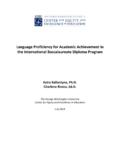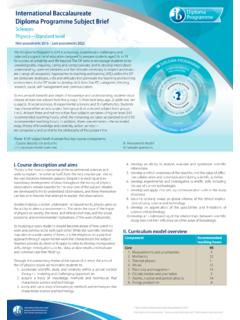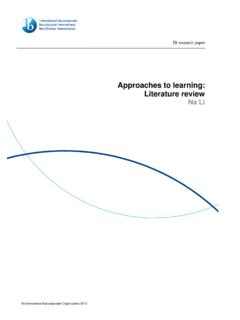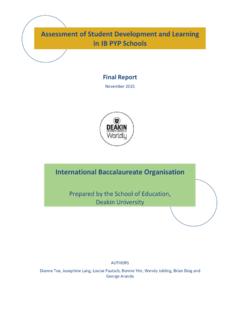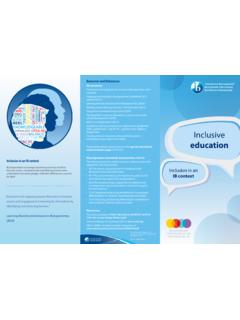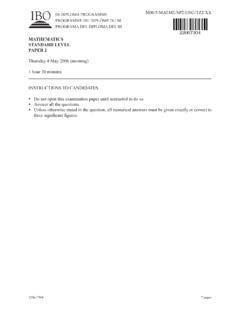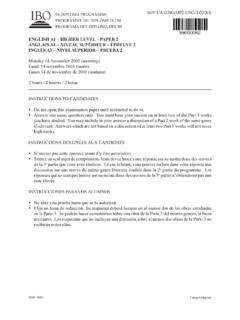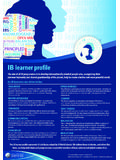Transcription of School Culture - International Baccalaureate
1 School Culture : Creating a unified Culture of learning in a multi-cultural setting Darlene Fisher IB Regional Conference October 2012 What we will discuss : what is it? School (organizational) Culture and societal Culture collaboration and PLCs related to education: School , community and national and variations - sometimes competing to overcome these differences to enhance collaboration consensus and moving forward an example Culture : what is it? School (organizational) and societal In groups discuss: do you define School Culture ? (What makes School Culture ?) do you define societal/national Culture ?
2 (What exemplifies national Culture ?) do they impact each other in your School (if at all)? a diagram of how they might be represented in a generic International School (how do they intersect?) School Culture According to Fullan (2007) School Culture can be defined as the guiding beliefs and values evident in the way a School operates. School Culture can be used to encompass all the attitudes, expected behaviors and values that impact how the School operates. National Culture Hofstede considers (national) Culture as The collective programming of the human mind The behaviors and beliefs characteristic of a particular social, ethnic or age group Model of School and social Culture Classroom Culture Societal/National Culture Community Culture School Culture Principal leading Learning outcomes Cheong, (2000) Cultural factors in School effectiveness: a framework for comparative work , School Leadership and Management 20(2) 207-225 Some questions to discuss: does your diagram compare?
3 How would an International School model with many cultures present in staff and students, be different from the previous model? strong are different national cultures present in your School ? To what extent do any represent different attitudes to education and what learning should look like? (this could be either among staff and/or students and parents) Why worry? Just because there are different national cultures within our staff, and/or parent body, do we as leaders have to adapt our leadership in any way? One person s experiences Bringing a quality Culture of coaching to a national School where the educational values and background of many teachers were often not compatible with the requirements for collaboration was well intentioned but not easy to achieve.
4 How was this to be understood, managed and hopefully overcome, so that a positive Culture of collaboration could develop in the School ? What is the importance of School Culture ? ..research strongly buttresses the central role of Culture to School success All of these studies and others .. point to the multiple ways School Culture fosters improvement, collaborative decision making, professional development and staff and STUDENT learning. Deal and Peterson Shaping School Culture Jossey-Bass e-book, introduction The research base and Impact p11. Understanding national cultures and educational values Collaboration depends on good communication and shared values.
5 National cultures can have different styles of communication , and different understandings of what good education looks like and what it should achieve. Once these differences are understood, they can be dealt with, and the collaboration required to develop professional learning communities can be more easily/possibly achieved intercultural communication Above surface, primarily in awareness Under surface primarily out of awareness Different values related to education: (cultural dimensions) ..affect teachers expectations of what happens in the classroom, how they should and can behave, how the students should and can behave, how they behave in meetings, how they communicate with colleagues, their line managers and eventually their This is based on Geert Hofstede s work on cultural dimensions Power Distance The extent to which the less powerful members of organizations and institutions accept and expect that power is distributed unequally.
6 Low PDI High PDI Education is more student centered, teachers expect children to take the initiative Teachers are experts who transfer impersonal truths Quality of learning depends on two way communication and excellence of STUDENTS Education is more teacher cenetred, they take all the initiative in class Teacher is seen as the guru who transfers personal wisdom and knowledge Quality of learning depends on excellence of TEACHER Power Distance Individualism vs Collectivism Individualism People are supposed to look after themselves and their direct family only.
7 Collectivism People belong to in-groups that take care of them, in exchange for loyalty. Low Individualism High Individuals do not speak unless mandated by the group Children learn how to do it in order to participate in society Individuals have to speak up and take initiative Children learn how to learn Uncertainty Avoidance Uncertainty avoidance The extent to which people feel threatened by ambiguous situations and have created beliefs and institutions that try to avoid these Low High Individuals accept open ended discussions and there is little need for one right answer The teacher may say I don t know
8 Individuals need structure and definite answers; want to know the right answer The teacher always needs to know all the answers, they are the expert Uncertainty Avoidance Hofstede s Cultural Dimensions Comparisons in action: A meeting is taking place (same meeting two countries) where teachers will design a PYP unit (under the theme of discoveries). One meeting is in Denmark The other meeting is in Turkey. For discussion: will the meeting be run/organised? will run the meeting? Who decides? talks in the meeting? When? long will the meeting take? Clue: review the countries cultural dimensions So what does this mean for us, our leadership and School cultures?
9 For School Culture to contribute to improved student learning it requires: A focus on learning (students and teachers) A focus on collaboration A focus on SMART goals and results It needs timely and relevant information Deal and Peterson For this to be achieved, there must be shared values, including: A willingness to acknowledge I don t know Being critical friends can be helpful, both for teaching and curriculum development teams Admitting you need help is not a sign of weakness but an indication of self awareness and growth Asking for help from a department head or team leader is ok, even expected, and will not be used against the teacher A willingness to listen to all ideas, and contribute regardless of acceptance of one s ideas or not Accepting responsibility for improving student learning and active research to decide how and what to improve, avoiding isolation BUT.
10 This is not easy to achieve when some accept these as normal and others don t For understanding to national cultural values have to be acknowledged, understood and worked with. set of essential agreements about how to work together in the School and PLCs need to be .. out on supported by the admin And all of these need to be clearly connected to the development of a School Culture that is focused on enhancing student learning One possible way forward Assuming the School leadership has agreed on a focus of developing a positive, pro-active, involved Culture of teaching an learning, possibly using Professional Learning Communities as the model, and this focus has been often and clearly communicated to the staff, then the following may work: time for discussion of School mission and values, the place of PLC s and School Culture .
